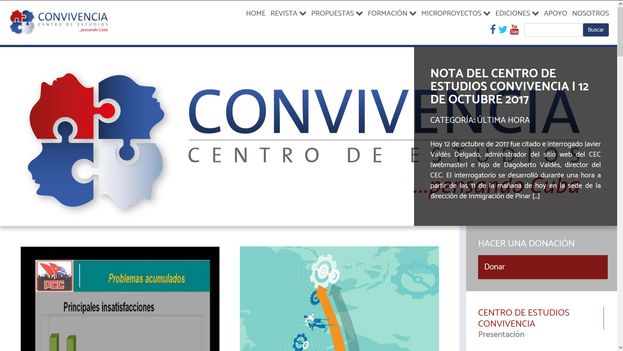
14ymedio, Yoani Sanchez, Havana, 15 October 2017 — It was April 2007 and a time of dark days. The most stagnant part of the Catholic Church intervened in the magazine Vitral (Stained Glass Window), shifting it away from its marked social mission. In the face of the hijacking, the editors jumped ship and months later founded the Proyecto Convivencia (Coexistence Project), which celebrates this October a decade of constant work.
The new publication was born under the influence of its predecessor, which had arisen in 1994 and came to have a circulation of 12,000 copies. However, from the beginning it became clear that the magazine Convivencia would be much more than a mere reflection of that stained glass window that stopped shining for diversity and reflected only pastoral issues.
In an environment of great debate and intense listening, the Catholic layman Dagoberto Valdés and his collaborators, working from Pinar del Rio, raised the first roof beams that would later cover not only that new publication, but also a project of civic development and a study center, both under the same name.
With the slogan “A threshold for citizenship and civil society in Cuba,” this triad has been a fresh wind in an independent sector where political approaches excessively prevail over social ones. Offering proposals rather than complaints became a part of the unique editorial and investigative seal of the project.
Unlike its predecessor, Convivencia placed its bets more on a digital presence. In times of blogging and Twitter accounts, its editorial board has relied on new technologies, and the web portal born of that vision has just updated its design, as well as offered more dynamic access to its content.
However, the biggest difference has been traveling the difficult road of offering information and opinion without the protection of the Church. To this difficulty is added that of maintaining a moderate profile in the midst of the polarization of Cuban society, the pressures of State Security and an intense campaign to discredit the project.
Seven years before Bishop Jorge Enrique Serpa Pérez forced a change of course on the Catholic publication, Valdés had been subjected to a harsh assault from two publishers of the official newspaper Granma, but the worst was yet to come. That was just the preamble to a sequence of interrogations and threats.
In this decade, members of Convivencia have experienced various forms of harassment. From constant police citations to a court’s latest decision to sentence Karina Gálvez, one of the leading publishers, to three years’ imprisonment and to confiscate her house which served as a headquarters.
Nor has there been a lack of criticism from other civil society groups in response to Convivencia’s approach of dialog, always maintained by the Pinar del Rio team, its position in favor of the diplomatic thaw between Cuba and the United States, and its use of respectful language toward any figure or institution. The project has paid a heavy price for its restraint.
In this landscape, the work of the Center for Coexistence Studies (CEC), which over a number of meetings has outlined an impressive reservoir of ideas and proposals for the future of the island, stands out. Culture, education, the media and economy are at the center of the analysis of this Cuban think tank, that labors without a lot of commotion, but without pause.
Together, the CEC, the civic center and the magazine seek “not only to educate citizens to exercise their own sovereignty but also work to have a vision of the future that will help to rebuild the nation,” Dagoberto Valdés proudly states. The man that the official propaganda calls a “mercenary” has only one obsession: to think about Cuba.
Today’s context is also very different than it was when the editors of today’s Convivencia began their work on the previous publication, at the end of the last century. Now, the spectrum of publications that address the issue of Cuba has grown both inside and outside the Island. Approaches have also diversified and readers have a flood of options from which to choose.
Other independent think tanks have also emerged and terms such as “community,” “civility” and “consensus” have become commonplace in the discourse of national activists. That light that began to peek through the stained glass of a magazine from Pinar del Rio, is today a common good that everyone shares.
Convivencia faces the challenges of surviving and growing: to avoid letting the repression make them adopt a discourse of denunciation rather than one of proposals; to overcome with their work the silence some want to impose on their very existence; to progress despite the insults others apply to their work; and to maintain their equanimity in times of hysteria.
The roof that began to rise in October of 2007 is complete, but within its interior there are still many subjects to address and innumerable situations on which to meditate. There is time for all that, because as emphasized in a recent statement the members of Convivencia Project, they have no plans to leave Cuba, Pinar del Rio or their civic space.
See also:
